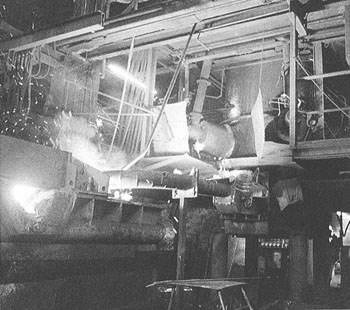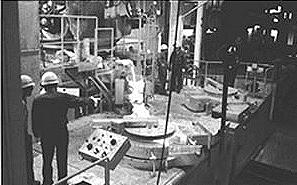It is
worth reminding the reader that a cupola is
a continuous melting shaft furnace which has by its inherent design
considerable advantages over batch type melters such as electric furnaces or
rotary furnaces. A cupola can accept a wide range of raw. materials including
oily, wet and contaminated scrap. These materials are unsuitable for electric
furnaces for safety reasons and because of the contamination their use is also
often limited for metallurgical reasons. In cupola melting there is a degree of
refining as the metal forms droplets during melting before collecting in the
well. Many contaminants are lost or reduced in value in this process whereas
when melting in electric furnaces or rotary furnaces whatever is in the charge
material finishes up in the liquid.
Additionally, the cupola is a
counterflow vertical shaft furnace and offers the high possibility of good
melting efficiency compared with batch type melters. Low top gas temperatures
mean a large proportion of the available heat goes into the metal whereas in
electric furnaces there are losses not only from the surface of the metal but
at least 25% of the energy input goes into the water in the induction coil. In
rotary furnaces high waste gas temperatures, even with recuperators mean high
losses.
The cokeless cupola has further advantages over the conventional
coke cupola. The waste gas has a low CO content and there is only 1% before
dilution which means the maximum heat is being released to the metal compared
with 12% to as high as 20% CO in' some coke operations which is a considerble
loss to the process. Eliminating coke removes the major source of pollution and
as there is no free oxygen in the cokeless in the cokeless cupola no
metallurgical fume is formed. Some coke cupolas particularly with oxygen
enrichment or oxygen injection produce considerable volumes of metallurgical
fume which then requires large filtration plants to remove it.
The
cokeless cupola can operate with no emission controls and still meet the new
environmental regulations providing the charge is clean and would be of a
similar cleanliness to that which is often required for electric melting. The
cost of such materials is often higher but can be justified to reduce the
capital investment of pollution control.
If cheaper contaminated scrap is used some emission control equipment
will be necessary but at a much lower cost. Even if a bag filter is required to
collect zinc fume from galvanised scrap a much smaller one can be used as the
volume and temperature of the waste gas is much lower than with a conventional
coke cupola. The cokeless cupola is an efficient melter which can solve the
environmental problem and additionally as there is no sulphur pick up in
melting it makes an ideal unit for the manufacture of base iron suitable for
ductile iron production.
Modern approach
The modern approach to
cokeless melting is to use the cupola as efficiently as possible and hence it
is a lined cupola although a water cooled shell is employed so it can be
operated on a long campaign basis. |
The cupola is operated at relatively
low tapping temperature to extend the refractory life and even with 40% steel
in the charge tapping temperatures of around 1,400oC are
employed and the metal then superheated and recarburised in a suitable electric
furnace. Such plants incorporating a single long campaign cokeless cupola
duplexing through electric furnaces are presently in use in Germany, Spain,
Japan and Korea with further installations going ahead in Austria and
Korea.
Economics
The economics of operating these plants are
obviously of considerable interest and the reader can be assured that they have
not been installed without the overall economics being attractive. The main
costs involved in cokeless melting are the fuel, refractory spheres,
electricity for superheating, plus lining refractory and recarburiser. In the
duplex operation gas consumptions of around 50cu m/tonne are typical which in
the UK means around £5-£6/tonne depending on the gas price. Sphere
consumptions below 1% have been achieved with typical consumptions around 1.2%
with 30% steel in the charge. This results in a melting cost of between
£5 and £6.50/tonne. The electricity for superheating at
50-70kWh/tonne adds between £2 and £3.50 depending on the amount of
superheating required and recarburiser to be added. The re-lining of the cupola
adds a further £3-4/tonne and the recarburiser £2-£5/tonne
depending whether petroleum coke or graphite is used and the actual addition.
This means the cost of simple grey iron melting can be as low as
£17/tonne and up to £24/tonne for ductile iron production with a
high steel charge and graphite for recarburising. These figures compare
favourably with conventional coke melting and are very attractive compared with
electric or rotary furnace operations.
For the UK foundry which has
existing cupolas a conversion can often be carried out to keep the capital cost
down compared with installing a complete new melting shop if the cupola is
abandoned. Obviously a new cokeless cupola plant can be built and may offer the
best efficiency but at a higher capital cost. Fig 1 shows a 12/14 tonnes/hour
plant operating in Germany. This single cupola duplexes through a small high
powered channel furnace where up to 1% carbon is added and the metal
superheated 200oC. Fig 2 shows a new 6 tonne/hour plant
in Japan which duplexes through two 3 tonne coreless induction furnaces. Fig 3
is a 4/5 tonne/hour cupola operating in Korea which feeds metal by ladle
transfer to existing electric furnaces. The cupola is not 'dead' in spite of
the bad press it occasionally receives. Its competitors try and make out it is
old fashioned but a modern approach means it still has a significant part to
play in providing liquid iron for foundries. By adopting a modern cokeless
cupola pIant a foundry can reduce its melting cost at the same time as solving
the environmental problem that exists with conventional coke cupolas. The
existing charge make-up can often be continued without the need of going to
clean high quality materials which are usually recommended for electric melting
particularly if they are being installed without emission controls. A cokeless
cupola plant is an efficient, clean, well controlled melting system to give the
foundry good flexibility of operation at low cost. 'Long live the cupola',
especially the modern cokeless cupola.
|


